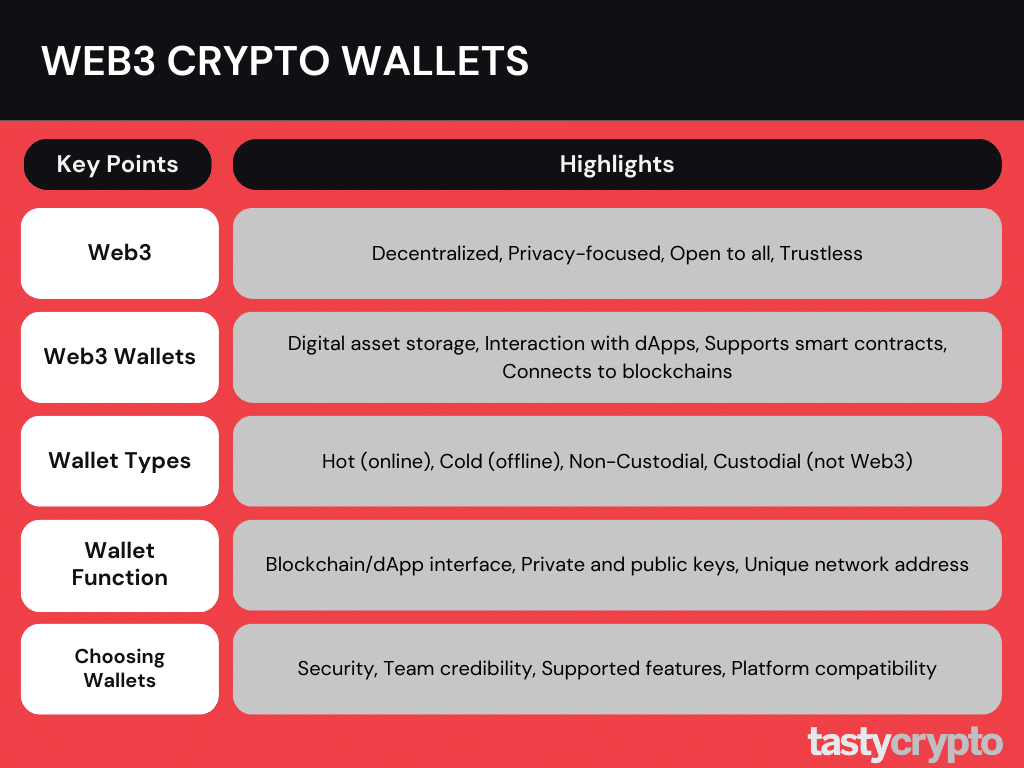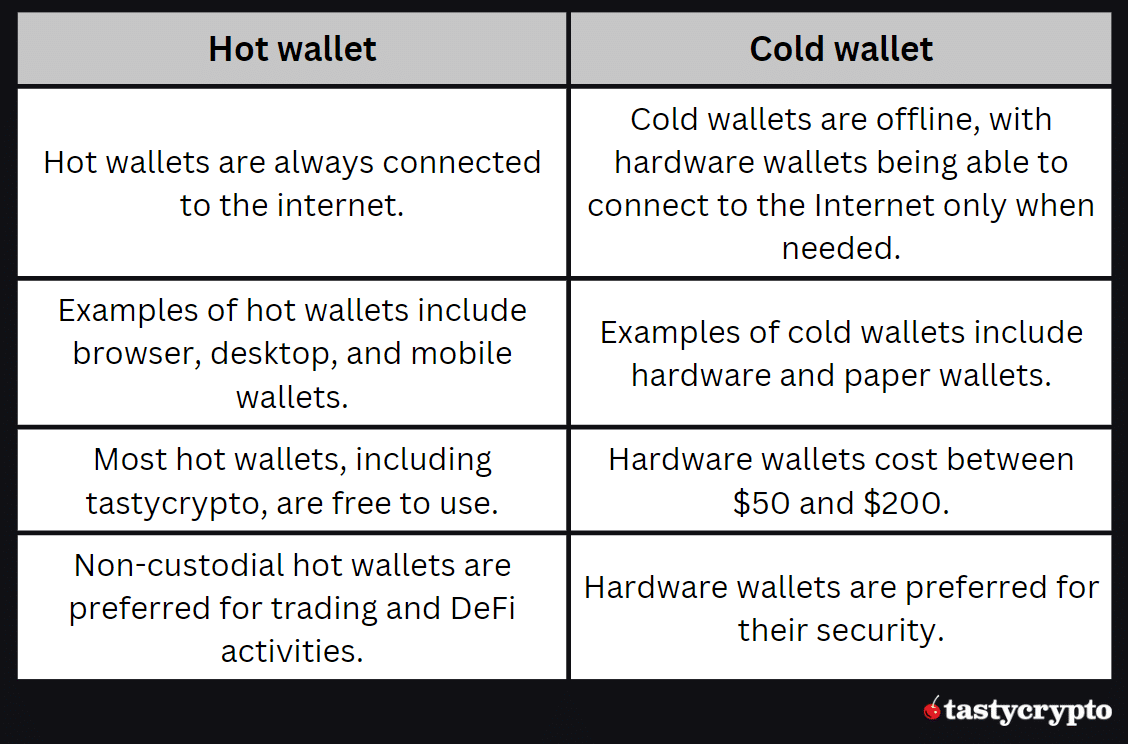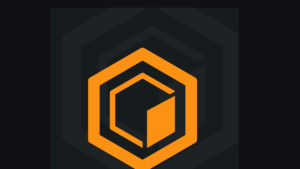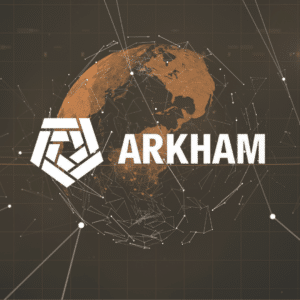Web3 Wallet Definition: A Web3 wallet (also called a self-custody wallet) grants users access to their private keys, which in turns allows Web3 wallets to connect to decentralized applications.
Written by: Siyu Ren Heinrich | Updated August 9, 2024
Reviewed by: Mike Martin
Fact checked by: Ryan Grace

Web3 wallets are crypto wallets that offer users additional functionalities and benefits. In this guide, we’ll help you understand the concept of Web3 wallets and guide you through the process of selecting the most suitable one for your needs.
Table of Contents
🍒 tasty takeaways
Web3 wallets prioritize decentralization and privacy, and they facilitate seamless interaction with blockchain technology without the need for trusted intermediaries.
Web3 wallets enable smooth engagement with decentralized applications (dApps) across various blockchains and facilitate the implementation of smart contracts.
When selecting a Web3 wallet, factors to consider include its security measures, array of features, and overall user experience.

What is Web3?
Web3 or Web 3.0 aims to fix many of the problems of today’s Internet (also referred to as Web2), such as monopolies and invasion of privacy. The following are key considerations:
Decentralization: no single individual or institution can gain control over other’s data and processes.
Privacy: all data is encrypted so that no conclusions can be drawn about the user.
Open: anyone can use the Web3 applications anonymously – regardless of location and other factors.
Trustless: codes and smart contracts take over the control of important processes, so users do not have to trust any third parties.
What Are Web3 Wallets?
A Web3 wallet (also call a decentralized wallet) is an application to store digital assets such as cryptocurrencies and NFTs. It also allows users to interact with decentralized apps (dApps) built on blockchain networks. Users can stake, exchange, borrow, or lend their cryptos within the Web3 wallet without having to send them to another address.
Web3 wallets have several special features:
They support the execution of smart contracts.
They hold the user’s private keys.
They connect users to multiple blockchains.
They provide seamless interaction with dApps through built-in functionalities.
What Are The Different Types Of Web3 Wallets?
A distinction is made between different types of crypto wallets:
A hot wallet is always connected to the internet. Hot wallets include desktop wallets, mobile wallets, and web wallets. They are designed for fast and convenient access to frequently used services. The constant connectivity also comes with higher security risks as hot wallets are more likely to be the target of hacks, phishing attempts, and malware. Examples of Web3 hot wallets are Metamask and tastycrypto, which are available in the form of browser extension and mobile Apps.
A cold wallet stores assets offline, typically on hardware devices (e.g. Ledger or Trezor) or paper wallets (paper printouts of the private keys). Their use is more cumbersome, but offers better protection of assets from hacks and other attacks.

By definition, a Web3 wallet must always be a non-custodial (self-custody) wallet, meaning that the user always has full control over their private keys and seed phrases.
A custodial wallet that is managed and controlled by third-party providers does not count as a Web3 wallet – even if it offers integration with dApps on different blockchains. For example, your account on a centralized crypto exchange is a custodial wallet.
🍒 Tip: Read our detailed comparison of non-custodial and custodial wallets.
How Do Web3 Wallets Work?
A Web3 wallet is best understood as an interface that allows a user to interact with various blockchains and the decentralized apps in their ecosystems. Each wallet has a unique private and public key.
The private key gives the user access to the funds associated with the wallet.
The public key encrypts the data and thus provides security.
Each wallet also has its own unique address, similar to a bank account number. This address is used to identify the wallet in the network. Through the wallet the user digitally verifies the ownership and transaction of assets such as cryptocurrencies and NFTs.
How To Choose A Web3 Wallet
Here are some important points to consider when choosing a suitable Web3 wallet:
1. How secure is the Web3 wallet?
Sadly, crypto offers a lot of opportunities for hackers. Once cryptocurrencies are lost, they are very difficult to recover. That is why security should be on the top of your list when choosing a Web3 wallet. Most of us are not security specialists. However, it is still possible to check how secure a wallet is:
When the code of a wallet is open source, it is always a good sign. Because the code can be checked by anyone around the world, it reduces the possibility of bugs and vulnerabilities.
The wallet has a good track record of keeping users’ digital assets safe since its launch.
The wallet has a security certification or auditing report from a trusted third party.
The wallet gets a lot of positive feedback and reviews on social media platforms and on independent reviewing websites.
The wallet offers various security features such as two-factor authentication (2FA) or automatic screen lock when inactive.
Read: tastycrypto Safety & Security Tips
2. Who is the team or company behind the web3 wallet?
This helps you to know if the wallet is built by someone with relevant experience and expertise. The track records of the people involved also show how much you can trust them. What you want to see here are people who have already realized successful crypto and Web3 projects in the past.
3. What are the features offered by the wallet?
There are many things to consider when it comes to the features of a wallet. For example:
Which crypto assets are supported by the wallet? Can it also store NFTs?
What kind of Web3 protocols are supported by the wallet? Can it be connected to decentralized exchanges and other DeFi protocols?
If you do a lot of transactions with Bitcoin (BTC), then it is important that it supports lightning network.
Can you use fiat currency to buy crypto using the wallet?
4. Does the wallet offer a good user experience?
A good Web3 wallet should be user-friendly. The following points are relevant:
The interface should be modern and comprehensible so that all important functions can be found easily.
The wallet should be accessible to all users. This means that it should be available as a mobile app (Android, iOS) as well as on desktop (Windows, Linux, iOS) via web browser.
The developers should also provide tutorials to teach beginners how to use the wallet’s functions.
What are some examples of popular Web3 wallets?
Tastycrypto is a universal self-custody Web3 wallet that supports hundreds of tokens. It comes in the form of a browser extension similar to MetaMask – probably the most popular Web3 wallet.
The most well-known hardware wallets are Ledger and Trezor.
Centralized crypto exchanges also provide non-custodial wallets, for example, Coinbase Wallet and Binance’s Trust Wallet.
There are wallets specially designed for the Ethereum blockchain, for example MyEtherWallet supports swaps between ETH and all ERC-20 tokens. Rainbow wallet supports token swap on Layer 2 protocols such as Polygon, Arbitrum, and Optimism.
Solana also has its native wallet: Phantom, which now supports multi-chains as well as several NFT marketplaces and DEXs.
A more general one is Exodus Web3 Wallet, which supports more than 10 networks including Ethereum, Binance Smart Chain as well as thousands of Web3 Apps. It can be downloaded on desktop and mobile devices and also comes as an extension of Chrome and Brave browsers.
FAQs
A self-custody Web3 wallet is safer than a custodial wallet because users have full control of their private keys. However, hacking risk remains.
Most Web3 wallets are free to download. However, it is worth noting that when using extra features provided by a wallet, there could be fees involved. This could be the case when you swap tokens and coins, buy cryptocurrencies, etc. Charging fees is a common way for wallet developers to generate revenue. Thus, it is important to compare fees charged by different wallets before deciding which one to use. Gas fees, however, must always be paid.

Siyu Ren Heinrich
5 years of experience in crypto research of writing practical blockchain and crypto analysis on Medium.
MSc in Computer Science, BSc in Smart Engineering, and BSc in Economics and Statistics.
Michael has been active in the crypto community since 2017. He holds certifications from Duke University in decentralized finance (DeFi) and blockchain technology.


The Core Blockchain and DeFi Ecosystem: What You Need to Know

7 Best DePIN Crypto Projects

What Is Symbiotic and How Does It Work in 2024?

Ethereum vs Ethereum ETFs – 5 Major Differences


